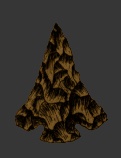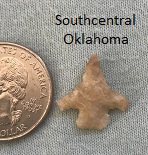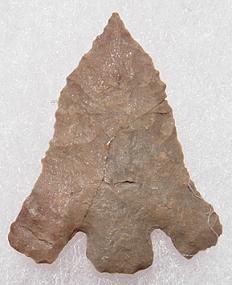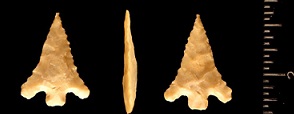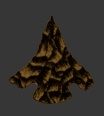Outline is Representative of Size and Shape:

Name Details:
Identified By: Clarence H. Webb and Hiram F. Gregory (named) / Robert Bell (detailed description)
Named For: Catahoula Lake, Catahoula Parish, Louisiana
Date Identified: 1956 (named) / 1960 (described)
Type Site: Sanson site (16RA ) near Catahoula Lake, Catahoula Parish, Louisiana
Identified By: Clarence H. Webb and Hiram F. Gregory (named) / Robert Bell (detailed description)
Named For: Catahoula Lake, Catahoula Parish, Louisiana
Date Identified: 1956 (named) / 1960 (described)
Type Site: Sanson site (16RA ) near Catahoula Lake, Catahoula Parish, Louisiana
Point Validity:
Valid type
Webb was a trained Pediatrician who became interested in archeology. In 1940 he became the charter member of the Society of American Archeology. He conducted many collaborative excavations and conducted his own excavations at Poverty Point and Gahagan Mounds. He was a well-respected Archaeologist. He named this point in a professional publication and this type has many professional references. This is a valid type.
Webb was a trained Pediatrician who became interested in archeology. In 1940 he became the charter member of the Society of American Archeology. He conducted many collaborative excavations and conducted his own excavations at Poverty Point and Gahagan Mounds. He was a well-respected Archaeologist. He named this point in a professional publication and this type has many professional references. This is a valid type.
Catahoula Stemmed
Cluster: Description of Physical Characteristics and Flaking Pattern:
This is a thin small to medium triangular stemmed to expanding stem point with a flattened cross section. The blade is broad and primarily recurvate curving in at the tip and flaring out at the shoulders edge. Some examples have had a straight blade. The blade broadest at the shoulders edge. The shoulder is barbed with large barbs which are rounded to squared. The stem is short and ranges from slightly expanding to expanding. The base is primarily convex, but may vary to straight. This point is commonly well made and has a random flaking pattern.
Size Measurements:
Total Length - 18 to 45 mm, Stem Length - 4 to 8 mm, Blade Width - 15 to 30 mm, Neck Width - 5 to 10 mm, Stem Width - 7 to 14 mm
Total Length - 18 to 45 mm, Stem Length - 4 to 8 mm, Blade Width - 15 to 30 mm, Neck Width - 5 to 10 mm, Stem Width - 7 to 14 mm
Commonly Utilized Material:
Locally available cobble cherts and “fossiliferous” chert, flint, and quartzite.
Locally available cobble cherts and “fossiliferous” chert, flint, and quartzite.
Additional Comments:
There are many similarities between the Catahoula point from south central region and the Eastgate point in the Desert Southwest and Far West regions. Leland W. Patterson (1976) conducted a distributional study of Catahoula points and concluded that the distribution extended into Nevada. However, this has not been supported by other researchers. There seems to be a gap between the distribution of the two types. The similarities of the two types may be of coincident rather than a transfer of technology between the two regions.
There are many similarities between the Catahoula point from south central region and the Eastgate point in the Desert Southwest and Far West regions. Leland W. Patterson (1976) conducted a distributional study of Catahoula points and concluded that the distribution extended into Nevada. However, this has not been supported by other researchers. There seems to be a gap between the distribution of the two types. The similarities of the two types may be of coincident rather than a transfer of technology between the two regions.
Distribution: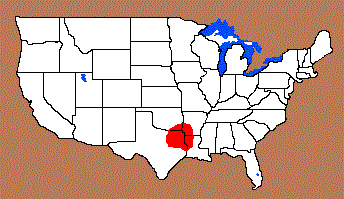
Distribution Comments:
This point is primarily found in north-central to northeastern Texas and into northwestern Louisiana. This point may be found into southwestern Arkansas and southeastern Oklahoma.
This point is primarily found in north-central to northeastern Texas and into northwestern Louisiana. This point may be found into southwestern Arkansas and southeastern Oklahoma.
Age / Periods:
Date: 1,300 - 900 B.P.
Cultural Period: Late Prehistoric
Glacial Period: Vandal Minimum to Medieval
Warm
Culture:
Date: 1,300 - 900 B.P.
Cultural Period: Late Prehistoric
Glacial Period: Vandal Minimum to Medieval
Warm
Culture:
Age Details:
Similar Points:
Agee, Alba, Bulbar, Bonham, Catahoula, Colbert, Cuney, Friley, Hayes, Hughes, Keota, Penwah Slough, Perdiz, Scallorn, Sequoyah
Agee, Alba, Bulbar, Bonham, Catahoula, Colbert, Cuney, Friley, Hayes, Hughes, Keota, Penwah Slough, Perdiz, Scallorn, Sequoyah
Other points in this cluster / Related / Associated Points:

